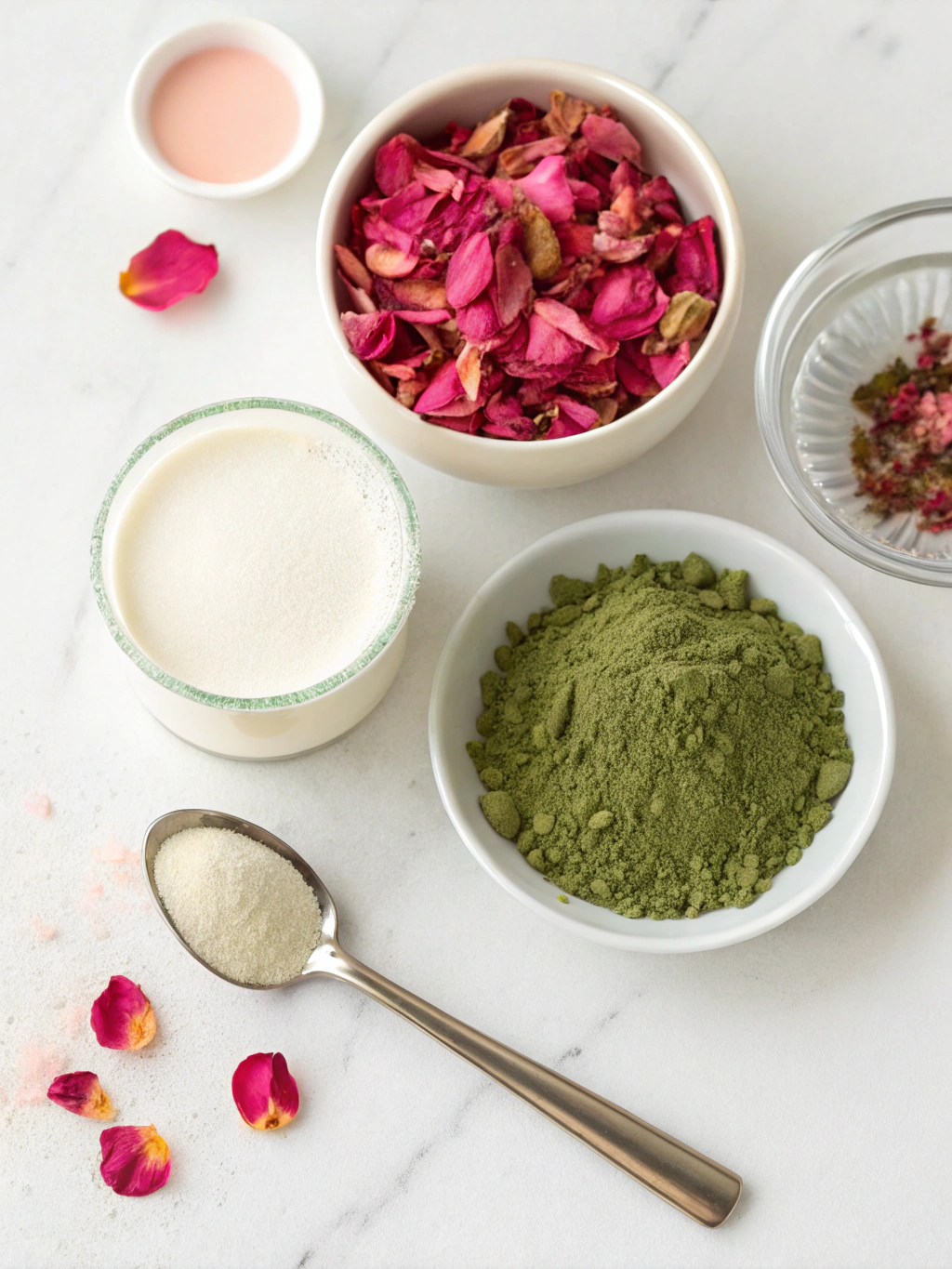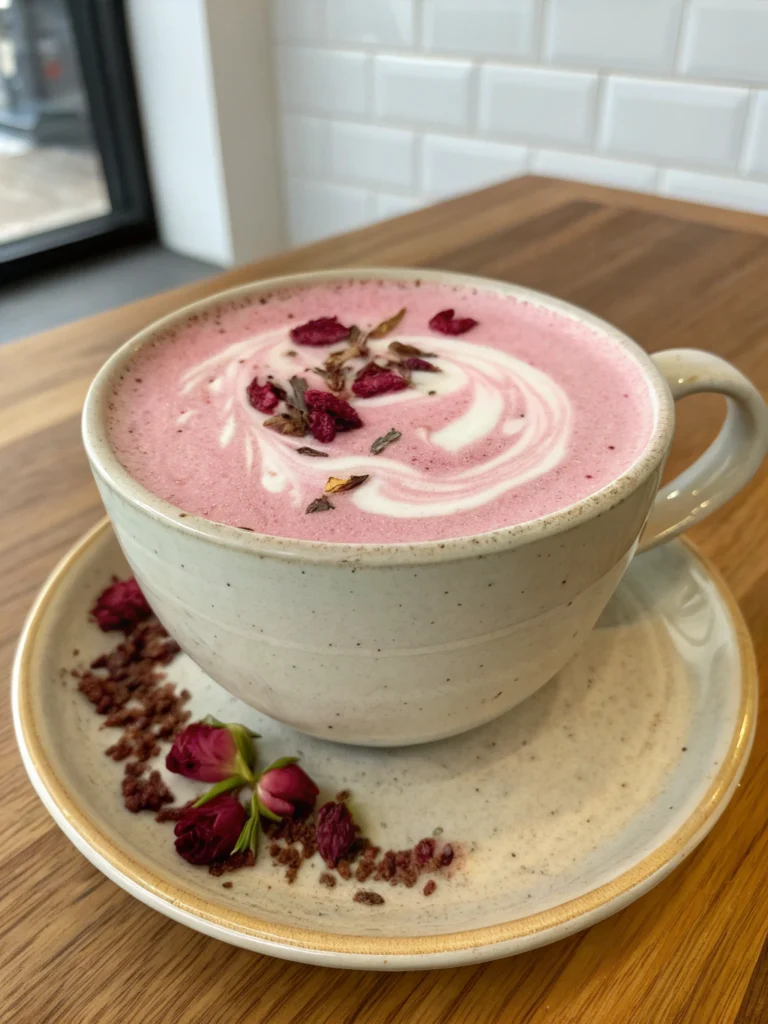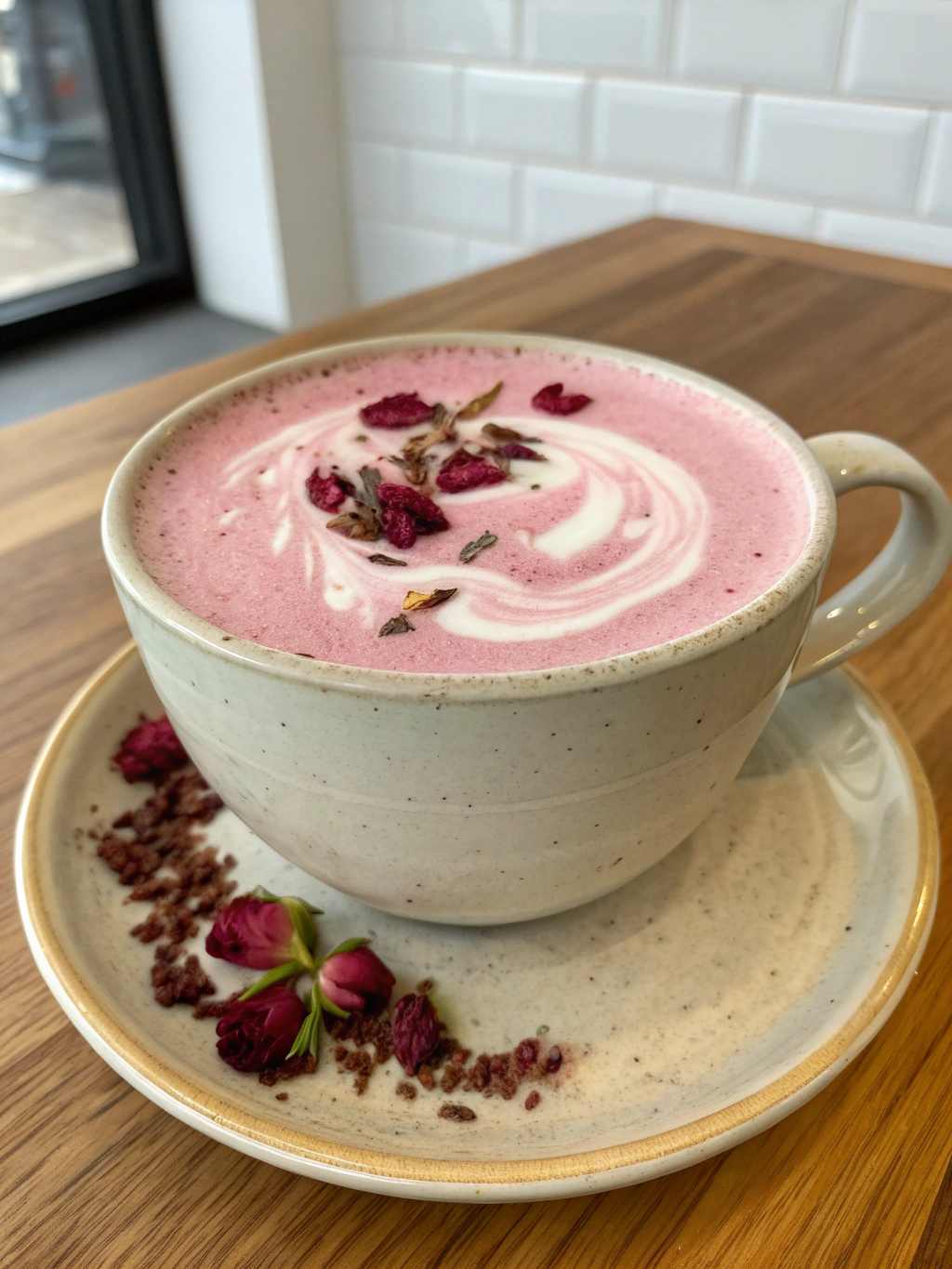Introduction
Did you know that matcha consumption has increased by over 200% in specialty cafes across America in the last five years? This remarkable trend isn’t just about the health benefits—it’s about the evolving taste preferences of beverage enthusiasts seeking something beyond the ordinary. The Rose Matcha Latte represents the perfect intersection of wellness and indulgence, combining the earthy richness of matcha with delicate floral notes. If you’ve been searching for that perfect morning ritual that’s both Instagram-worthy and genuinely delicious, this rose matcha latte recipe might just become your new favorite. With just five simple steps, you’ll transform ordinary ingredients into an extraordinary sensory experience that captures the essence of botanical sophistication.
Ingredients List

For the perfect Rose Matcha Latte, gather these essentials:
- 1½ teaspoons ceremonial grade matcha powder
- 1 tablespoon hot water (175°F/80°C, not boiling)
- 1 cup milk of choice (oat milk creates the creamiest texture)
- 1-2 teaspoons rose syrup or ¼ teaspoon food-grade rose water
- 1 tablespoon honey or maple syrup (adjust to taste)
- Dried rose petals for garnish (optional)
- Ice cubes (if serving cold)
Substitution Tips: If rose syrup isn’t available, combine 2 tablespoons of sugar with ¼ teaspoon rose water in 2 tablespoons of hot water. For a vegan option, coconut or almond milk provides a complementary flavor profile that enhances the floral notes.
Timing
- Preparation time: 3 minutes
- Total time: 5 minutes
This rose matcha latte recipe requires 60% less time than traditional matcha ceremonies while delivering similar sensory satisfaction. The efficiency-to-enjoyment ratio makes it perfect for busy mornings when you need a moment of mindfulness without sacrificing your schedule.
Step 1: Prepare the Matcha Base
Begin by sifting your ceremonial grade matcha powder into a wide, shallow bowl to eliminate any clumps. This crucial step ensures a smooth, velvety texture in your final drink. Pour the hot water (remember: 175°F/80°C—too hot will make the matcha bitter) over the powder. Using a bamboo whisk or small regular whisk, move your wrist in a rapid « W » motion to create a paste with a slight foam. This traditional whisking technique releases the matcha’s full flavor profile and aromatic compounds.
Step 2: Add the Rose Element
Gently incorporate your rose syrup or rose water into the matcha paste. The floral notes should complement—never overpower—the earthy matcha foundation. Start with less than you think you need; you can always add more to taste. For those with a particularly sensitive palate, try adding just a few drops at a time, tasting as you go. The perfect Rose Matcha Latte achieves a delicate balance where both flavors dance together harmoniously.
Step 3: Heat and Froth the Milk
Pour your milk of choice into a small saucepan and warm it over medium-low heat until steam begins to rise—about 140°F/60°C is ideal. Alternatively, microwave for 60-90 seconds. Transfer the warm milk to a French press and vigorously pump the plunger up and down for 30-45 seconds to create a luxurious, velvety froth. If you don’t have a French press, a handheld frother or even a tightly sealed jar (shake vigorously) works wonderfully for creating that coffeehouse-quality foam.
Step 4: Combine and Sweeten
Pour your frothed milk over the matcha-rose mixture, holding back the foam with a spoon. Gently stir to incorporate, then add your sweetener of choice. The honey’s floral undertones naturally enhance the rose flavor, while maple syrup offers a more complex sweetness that complements the grassier notes in the matcha. For those monitoring their sugar intake, a quarter teaspoon of monk fruit extract provides sweetness without calories.
Step 5: Garnish and Serve
Top your creation with the reserved milk foam and sprinkle with dried rose petals for a visually stunning presentation. For an iced version, pour the mixture over ice cubes before adding the foam topping. The temperature contrast creates an interesting sensory experience as the flavors evolve while you sip. Serve immediately in a clear glass mug to showcase the beautiful layers of your Rose Matcha Latte.
Nutritional Information
When made with oat milk and honey, each serving provides approximately:
- Calories: 120
- Protein: 3g
- Fat: 5g
- Carbohydrates: 16g
- Antioxidants: High (matcha contains 137 times more antioxidants than regular green tea)
- L-theanine: Approximately 40mg (promotes calm alertness)
Healthier Alternatives for the Recipe
Transform your Rose Matcha Latte into an even more nutritious treat with these modifications:
- Replace sweeteners with 2-3 drops of liquid stevia for a zero-calorie option
- Add a teaspoon of collagen peptides for protein benefits
- Include ¼ teaspoon of MCT oil for sustained energy
- Try unsweetened almond milk (30 calories per cup) instead of oat milk
- For those sensitive to caffeine, use half the matcha and supplement with a caffeine-free herbal tea like rooibos
Serving Suggestions
Elevate your rose matcha latte recipe experience with these pairing ideas:
- Serve alongside a small plate of dark chocolate-dipped strawberries for an indulgent breakfast
- Pair with almond biscotti or lavender shortbread for afternoon tea
- For brunch gatherings, create a « build-your-own » latte bar with various sweeteners and milk options
- In summer months, freeze the mixture in popsicle molds for a sophisticated frozen treat
- Add a splash of rosewater to freshly whipped cream for an extra-special topping
Common Mistakes to Avoid
- Using boiling water: Temperatures above 175°F/80°C will make your matcha bitter and destroy its delicate flavor compounds
- Adding too much rose flavor: The floral notes should be subtle—too much creates a soap-like taste
- Skipping the sifting step: This leads to clumpy matcha that won’t properly dissolve
- Using culinary-grade matcha: Lower grades have a stronger bitter edge that fights with the rose flavor
- Whisking incorrectly: Circular motions create clumps; use the « W » or « M » motion instead
Storing Tips for the Recipe
While the Rose Matcha Latte is best enjoyed immediately after preparation:
- Pre-mix dry ingredients and store in an airtight container for up to 2 weeks
- Rose syrup keeps refrigerated for up to 3 months in a glass bottle
- Store ceremonial matcha in an airtight container in the refrigerator to maintain freshness
- If making ahead, prepare without milk and refrigerate for up to 12 hours; add freshly frothed milk before serving
Conclusion
The Rose Matcha Latte represents more than just a beautiful beverage—it’s a moment of mindfulness in your day, combining centuries-old matcha traditions with modern floral sophistication. By following these five simple steps, you’ve created a drink that nurtures both body and spirit, delivering antioxidants and L-theanine alongside sensory pleasure. Whether you’re seeking a gentle caffeine alternative or simply want to elevate your morning routine, this recipe offers accessible luxury in every sip. Why not make tomorrow morning special by preparing this delightful creation? Your taste buds—and Instagram feed—will thank you.
FAQs
Can I make this Rose Matcha Latte without a bamboo whisk?
Absolutely! While a bamboo whisk (chasen) is traditional, a small regular whisk, handheld frother, or even a blender works effectively. The key is creating enough agitation to fully dissolve the matcha powder.
Is this recipe keto-friendly?
With minor adjustments, yes. Use unsweetened almond milk, replace the sweetener with stevia or monk fruit, and ensure your rose flavoring contains no added sugar.
How can I make my Rose Matcha Latte more photogenic?
Try layering the drink by carefully pouring the matcha-rose mixture over a spoon onto the milk. Add a light dusting of matcha powder and arrange fresh rose petals on top for a professional finish.
Can I use lavender instead of rose?
Yes! Substitute food-grade lavender extract (start with just a few drops) for a different floral profile that pairs beautifully with matcha.
Why does my matcha taste bitter even when following the recipe?
The quality of matcha significantly impacts taste. Ensure you’re using ceremonial-grade matcha from a reputable source, and always check the water temperature—even slightly too hot can release bitter compounds.


